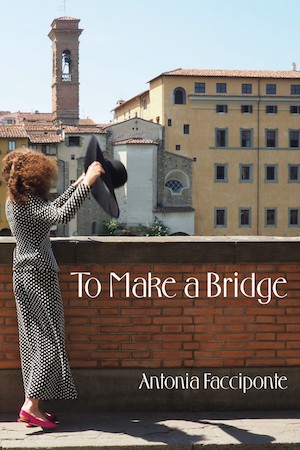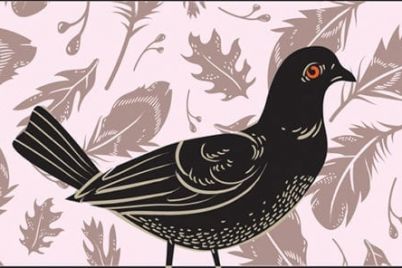In the beginning there is a bridge, and we are standing beneath it, “eyelids sutured / over iris by the smooth / starless underbelly / of infrastructure.”
We are blind beneath this bridge, this infrastructure; trapped between its belly and the dirt, unable to witness the moon, the stars, and the trees that create a landscape, in which “mischievous magpies of creativity” can roam freely. But then, “[a]n unknown / lunar voice gleams like lamplight,” and we are invited to listen, to follow this synesthetic sound of light, and to emerge from the underbelly of the bridge into something like a wonderland, “an upside-down verse of / understanding.”
This is how Antonia Facciponte’s debut collection of poetry, To Make a Bridge, opens. I find this moment, the Overture, stunning for the way in which its points of deliberate slowness (“the smooth, starless underbelly”) are clipped by the sharp consonants of words like protects, perception, possibility. This initial page gives readers a sense that something great, a heavy boulder barring the mouth of an ancient cave, is being uplifted. Images of a wide-open yawn, a swooping swallow, come to mind as this poem unfolds. Readers are encouraged to abandon their shelter, to enlighten their understanding of the world around them, by crossing paths with the “serenading sheen” of moonlight, the “lunar voice” of the poet.
So many beautiful moments in this overture alone – rich traces of alliteration, the subtle onomatopoeia of words like yowl and aubade – it makes the task of summing it all up in this short review all the more challenging. But I digress.
Facciponte’s collection has two acts, each of which aptly explores the book’s fundamental theme of Italo-Canadian culture. Act I, “L’arte della famiglia,” is, as its title suggests, devoted to the family, the nonni and nonne, zios and zias. Act II, “L’arte culinaria,” explores the palate of traditional Southern Italian food, from fresh sugo to “orange slices with olive oil and pepper.” Meanwhile, at the heart of this collection, there is a fervent desire to connect the past to the present, to “spell out another bridge” with “mouthfuls of ink.” And so, while the hand of the poet makes bridges out of words, the hands of the older generations – nonnas and nonnos, subjects of Facciponte’s book – are making bridges out of “precious plates of penne, heart / raving ravioli,” hand-carved oak cabinets, and the dismembered limbs of moldy sheds.
As with any opera, Facciponte’s tells a story, but not without a quality of conscious reflection. Each poem is an ode to the past, a glimpse of a moment passed down and made crucial by the sheer act of recreation. Recipes, anecdotes, and letters provide a “steady beat of song,” much like how the rosary beads of “Good Friday, 2019” guide the poet’s ancestors in their mourning of Jesus on the cross. It is an act of love, this poetic recreation, a sacred act of drawing from history. In an age of exponential growth, where everything seems to be expanding beyond our perceptive abilities, drawing from the pasts of those who love and nurture us is something we should aspire to more as writers, deep thinkers, students, and teachers. Remember the past, honour our ancestors. To Make a Bridge is published by Black Moss Press.
Juliann Garisto is a writer and editor in Toronto. She is currently studying Creative Writing at the University of Toronto, and edits prose for the Hart House Review.





